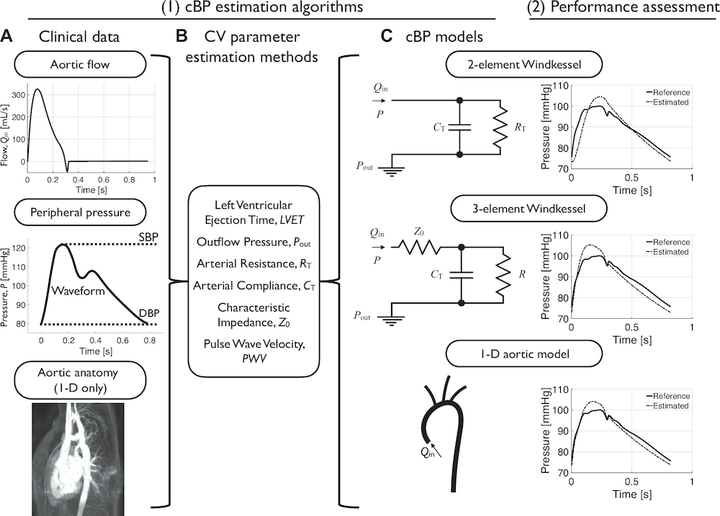Estimating central blood pressure from aortic flow: development and assessment of algorithms
 Image credit: J. Mariscal Harana et al. (CC BY 4.0)
Image credit: J. Mariscal Harana et al. (CC BY 4.0)
Abstract
Central blood pressure (cBP) is a highly prognostic cardiovascular (CV) risk factor whose accurate, invasive assessment is costly and carries risks to patients. We developed and assessed novel algorithms for estimating cBP from noninvasive aortic hemodynamic data and a peripheral blood pressure measurement. These algorithms were created using three blood flow models: the two- and three-element Windkessel (0-D) models and a one-dimensional (1-D) model of the thoracic aorta. We tested new and existing methods for estimating CV parameters (left ventricular ejection time, outflow BP, arterial resistance and compliance, pulse wave velocity, and characteristic impedance) required for the cBP algorithms, using virtual (simulated) subjects (n = 19,646) for which reference CV parameters were known exactly. We then tested the cBP algorithms using virtual subjects (n = 4,064), for which reference cBP were available free of measurement error, and clinical datasets containing invasive (n = 10) and noninvasive (n = 171) reference cBP waves across a wide range of CV conditions. The 1-D algorithm outperformed the 0-D algorithms when the aortic vascular geometry was available, achieving central systolic blood pressure (cSBP) errors ≤ 2.1 ± 9.7 mmHg and root-mean-square errors (RMSEs) ≤ 6.4 ± 2.8 mmHg against invasive reference cBP waves (n = 10). When the aortic geometry was unavailable, the three-element 0-D algorithm achieved cSBP errors ≤ 6.0 ± 4.7 mmHg and RMSEs ≤ 5.9 ± 2.4 mmHg against noninvasive reference cBP waves (n = 171), outperforming the two-element 0-D algorithm. All CV parameters were estimated with mean percentage errors ≤ 8.2%, except for the aortic characteristic impedance (≤13.4%), which affected the three-element 0-D algorithm’s performance. The freely available algorithms developed in this work enable fast and accurate calculation of the cBP wave and CV parameters in datasets containing noninvasive ultrasound or magnetic resonance imaging data.